Effective Talent Management Strategies at Parcelforce: Analysis
VerifiedAdded on 2023/06/18
|23
|5553
|256
Report
AI Summary
This report explores the talent management strategies employed by Parcelforce to attract and retain employees. It begins with a project plan outlining the research aim, objectives, and questions, followed by a literature review discussing the role and importance of talent management, specific strategies used by Parcelforce, and the challenges faced in their implementation. The research employs a quantitative approach, using questionnaires to gather primary data from 30 Parcelforce employees. The findings are presented through data analysis and visualizations, highlighting employee awareness of talent management, its significance, key factors, and associated challenges. The report concludes with recommendations for Anderson transport, a small transport goods service provider, based on the Parcelforce case study, and a reflection on the research process. The study emphasizes the importance of talent management in enhancing organizational performance and employee retention.
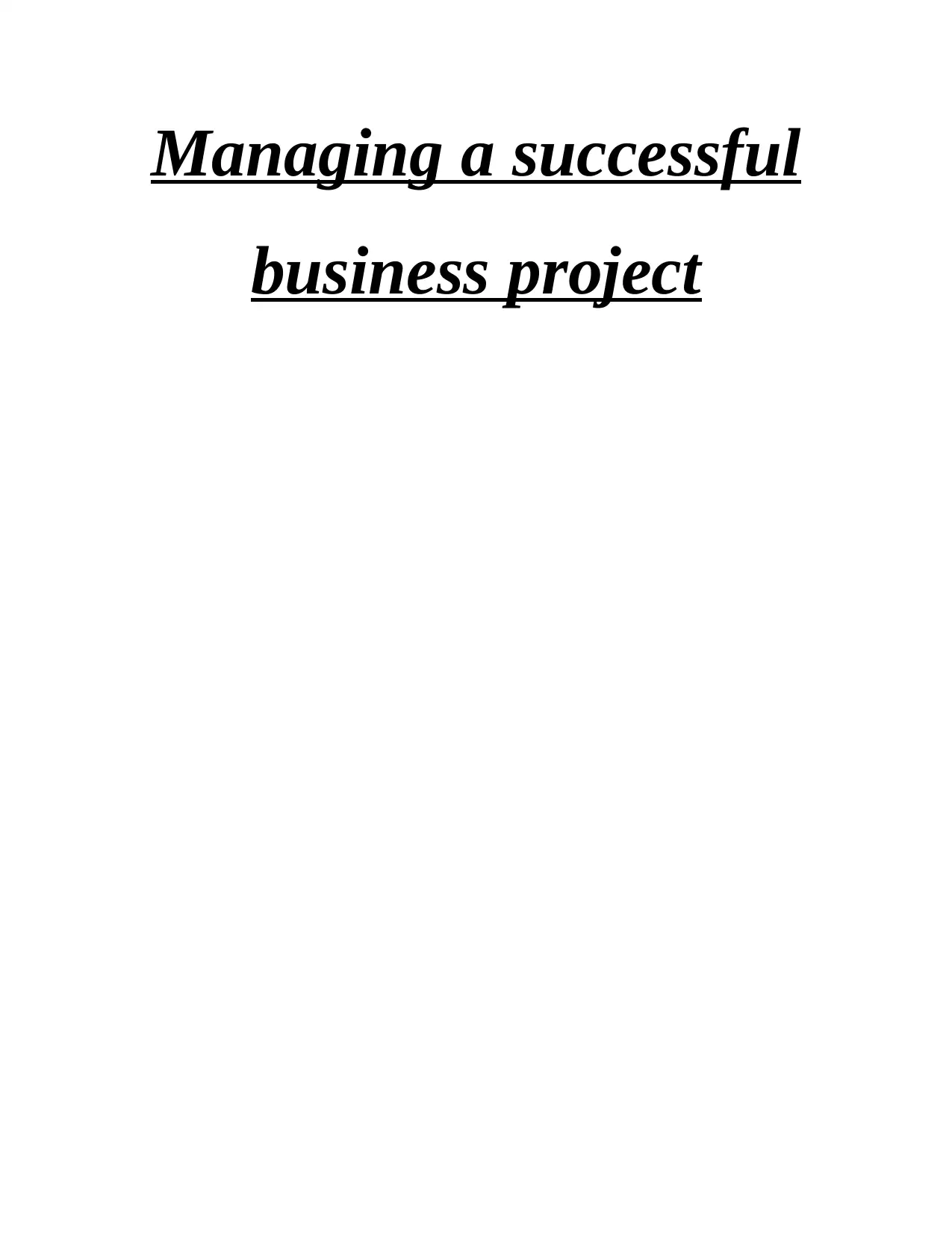
Managing a successful
business project
business project
Paraphrase This Document
Need a fresh take? Get an instant paraphrase of this document with our AI Paraphraser
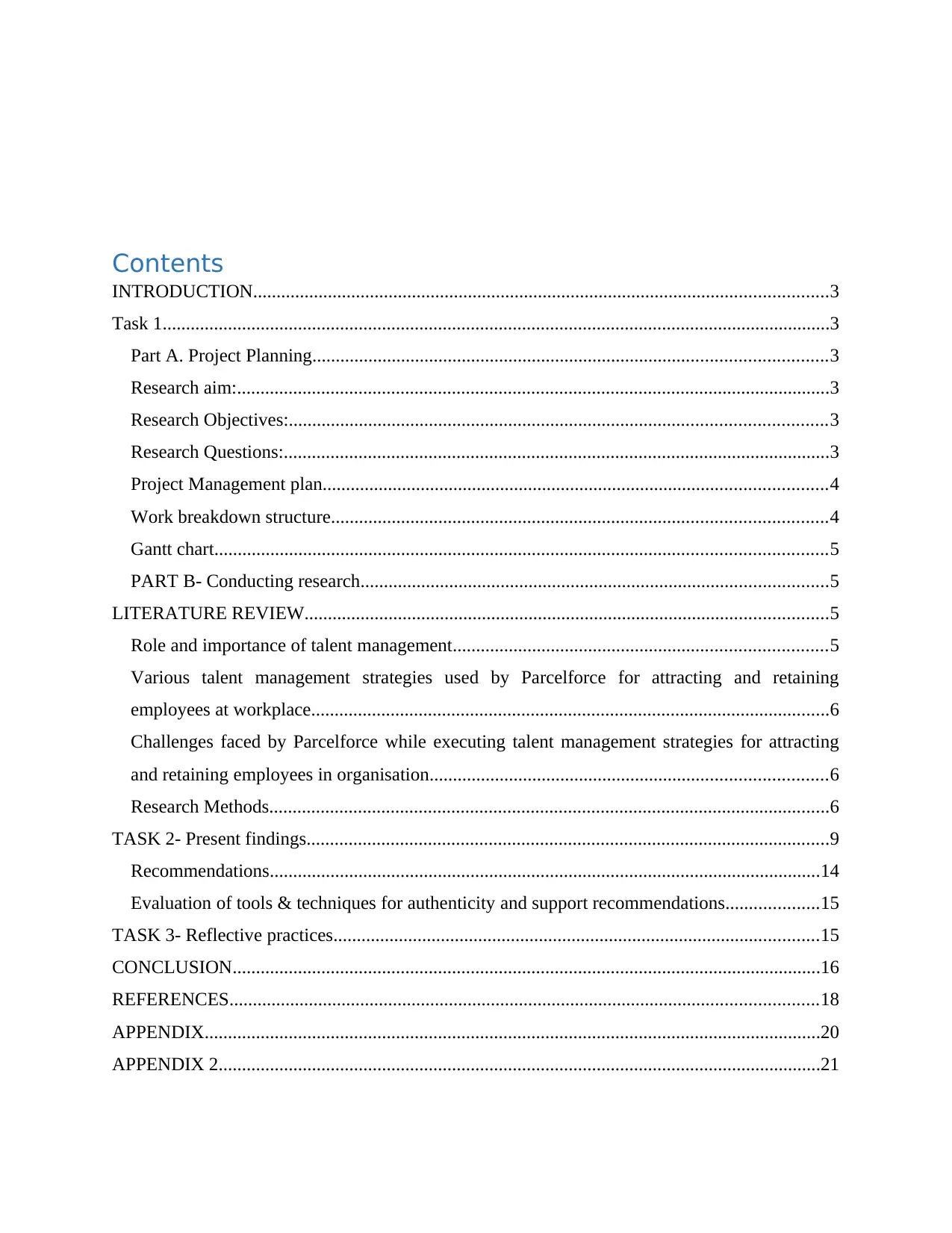
Contents
INTRODUCTION...........................................................................................................................3
Task 1...............................................................................................................................................3
Part A. Project Planning..............................................................................................................3
Research aim:...............................................................................................................................3
Research Objectives:...................................................................................................................3
Research Questions:.....................................................................................................................3
Project Management plan............................................................................................................4
Work breakdown structure..........................................................................................................4
Gantt chart...................................................................................................................................5
PART B- Conducting research....................................................................................................5
LITERATURE REVIEW................................................................................................................5
Role and importance of talent management................................................................................5
Various talent management strategies used by Parcelforce for attracting and retaining
employees at workplace...............................................................................................................6
Challenges faced by Parcelforce while executing talent management strategies for attracting
and retaining employees in organisation.....................................................................................6
Research Methods........................................................................................................................6
TASK 2- Present findings................................................................................................................9
Recommendations......................................................................................................................14
Evaluation of tools & techniques for authenticity and support recommendations....................15
TASK 3- Reflective practices........................................................................................................15
CONCLUSION..............................................................................................................................16
REFERENCES..............................................................................................................................18
APPENDIX....................................................................................................................................20
APPENDIX 2.................................................................................................................................21
INTRODUCTION...........................................................................................................................3
Task 1...............................................................................................................................................3
Part A. Project Planning..............................................................................................................3
Research aim:...............................................................................................................................3
Research Objectives:...................................................................................................................3
Research Questions:.....................................................................................................................3
Project Management plan............................................................................................................4
Work breakdown structure..........................................................................................................4
Gantt chart...................................................................................................................................5
PART B- Conducting research....................................................................................................5
LITERATURE REVIEW................................................................................................................5
Role and importance of talent management................................................................................5
Various talent management strategies used by Parcelforce for attracting and retaining
employees at workplace...............................................................................................................6
Challenges faced by Parcelforce while executing talent management strategies for attracting
and retaining employees in organisation.....................................................................................6
Research Methods........................................................................................................................6
TASK 2- Present findings................................................................................................................9
Recommendations......................................................................................................................14
Evaluation of tools & techniques for authenticity and support recommendations....................15
TASK 3- Reflective practices........................................................................................................15
CONCLUSION..............................................................................................................................16
REFERENCES..............................................................................................................................18
APPENDIX....................................................................................................................................20
APPENDIX 2.................................................................................................................................21
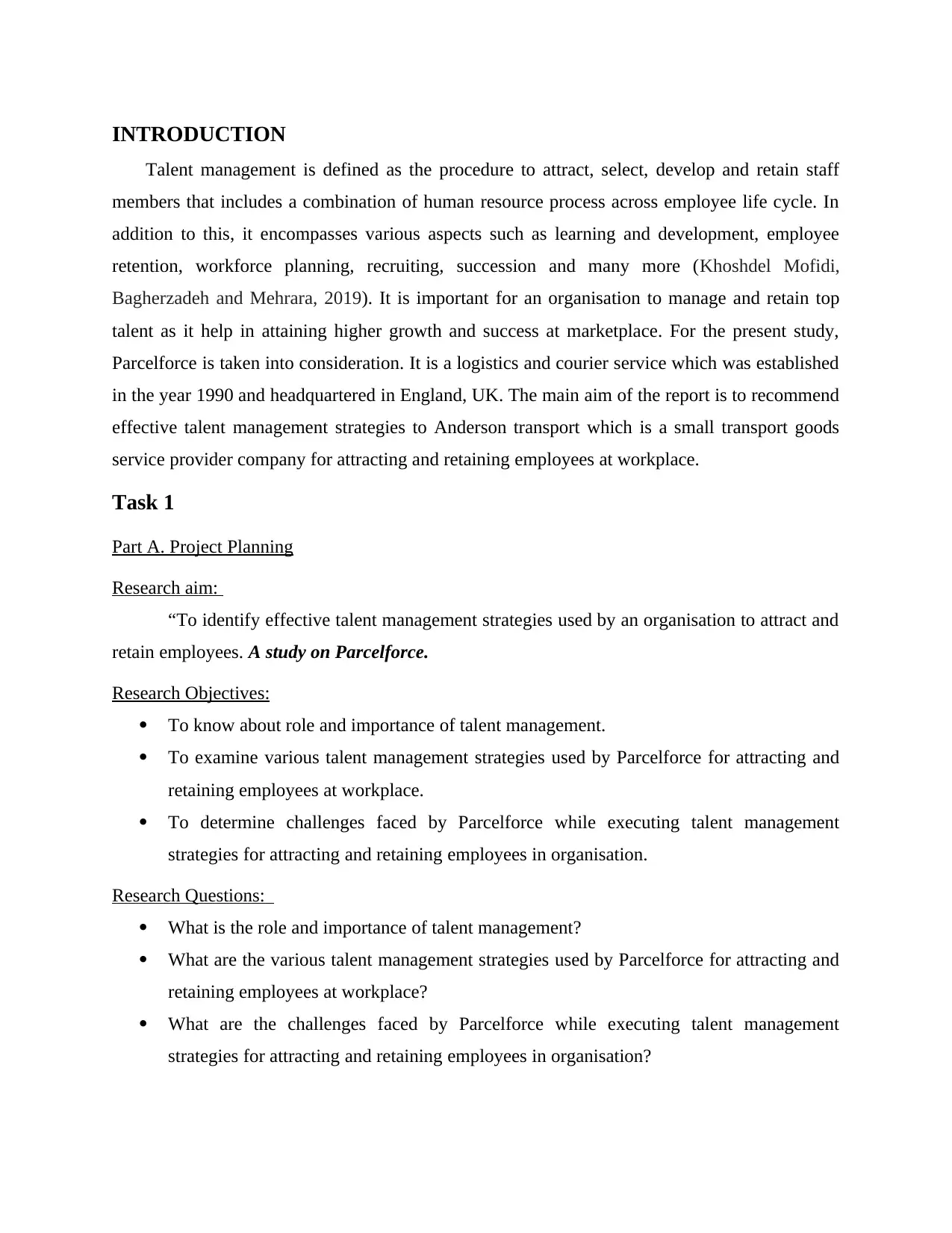
INTRODUCTION
Talent management is defined as the procedure to attract, select, develop and retain staff
members that includes a combination of human resource process across employee life cycle. In
addition to this, it encompasses various aspects such as learning and development, employee
retention, workforce planning, recruiting, succession and many more (Khoshdel Mofidi,
Bagherzadeh and Mehrara, 2019). It is important for an organisation to manage and retain top
talent as it help in attaining higher growth and success at marketplace. For the present study,
Parcelforce is taken into consideration. It is a logistics and courier service which was established
in the year 1990 and headquartered in England, UK. The main aim of the report is to recommend
effective talent management strategies to Anderson transport which is a small transport goods
service provider company for attracting and retaining employees at workplace.
Task 1
Part A. Project Planning
Research aim:
“To identify effective talent management strategies used by an organisation to attract and
retain employees. A study on Parcelforce.
Research Objectives:
To know about role and importance of talent management.
To examine various talent management strategies used by Parcelforce for attracting and
retaining employees at workplace.
To determine challenges faced by Parcelforce while executing talent management
strategies for attracting and retaining employees in organisation.
Research Questions:
What is the role and importance of talent management?
What are the various talent management strategies used by Parcelforce for attracting and
retaining employees at workplace?
What are the challenges faced by Parcelforce while executing talent management
strategies for attracting and retaining employees in organisation?
Talent management is defined as the procedure to attract, select, develop and retain staff
members that includes a combination of human resource process across employee life cycle. In
addition to this, it encompasses various aspects such as learning and development, employee
retention, workforce planning, recruiting, succession and many more (Khoshdel Mofidi,
Bagherzadeh and Mehrara, 2019). It is important for an organisation to manage and retain top
talent as it help in attaining higher growth and success at marketplace. For the present study,
Parcelforce is taken into consideration. It is a logistics and courier service which was established
in the year 1990 and headquartered in England, UK. The main aim of the report is to recommend
effective talent management strategies to Anderson transport which is a small transport goods
service provider company for attracting and retaining employees at workplace.
Task 1
Part A. Project Planning
Research aim:
“To identify effective talent management strategies used by an organisation to attract and
retain employees. A study on Parcelforce.
Research Objectives:
To know about role and importance of talent management.
To examine various talent management strategies used by Parcelforce for attracting and
retaining employees at workplace.
To determine challenges faced by Parcelforce while executing talent management
strategies for attracting and retaining employees in organisation.
Research Questions:
What is the role and importance of talent management?
What are the various talent management strategies used by Parcelforce for attracting and
retaining employees at workplace?
What are the challenges faced by Parcelforce while executing talent management
strategies for attracting and retaining employees in organisation?
⊘ This is a preview!⊘
Do you want full access?
Subscribe today to unlock all pages.

Trusted by 1+ million students worldwide
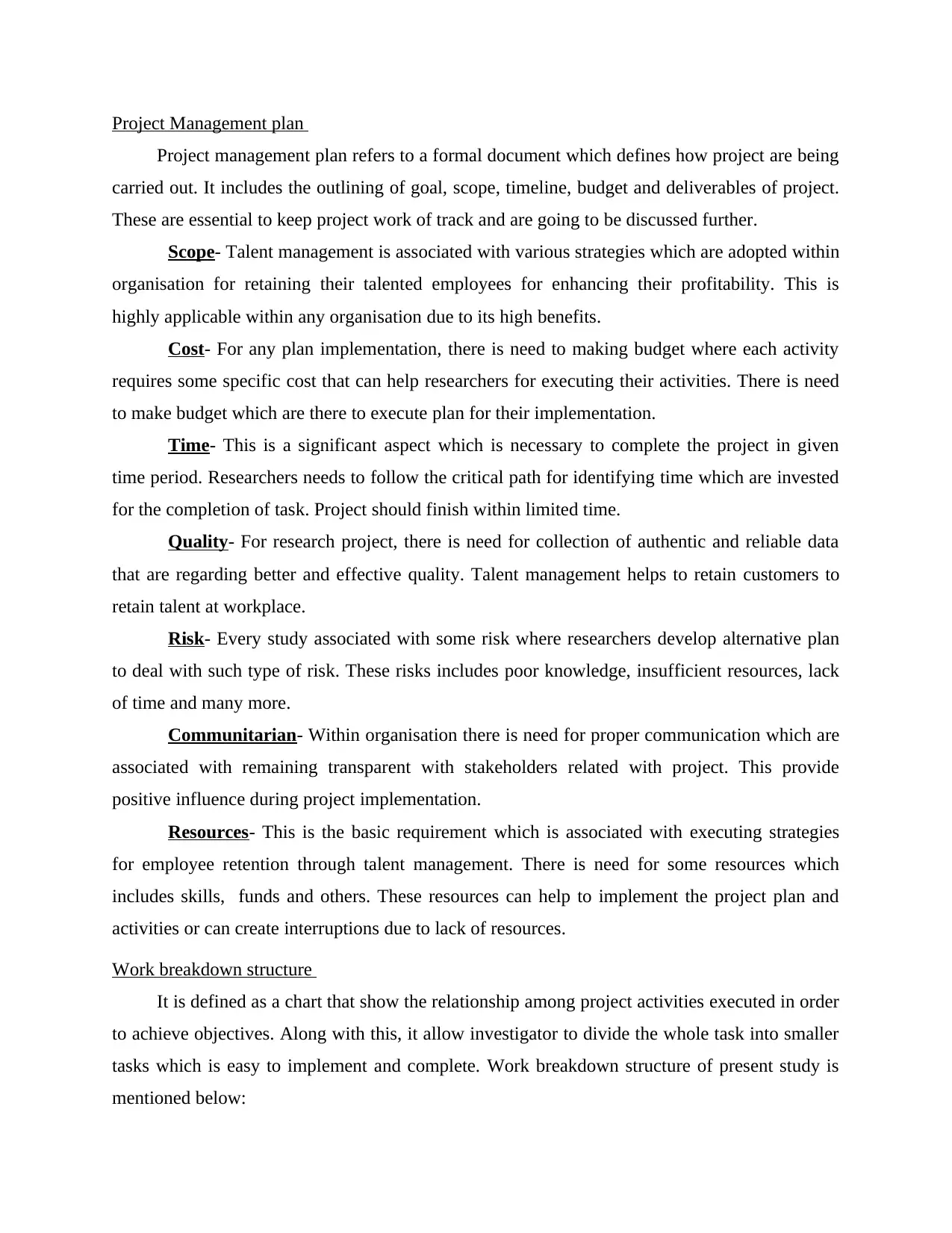
Project Management plan
Project management plan refers to a formal document which defines how project are being
carried out. It includes the outlining of goal, scope, timeline, budget and deliverables of project.
These are essential to keep project work of track and are going to be discussed further.
Scope- Talent management is associated with various strategies which are adopted within
organisation for retaining their talented employees for enhancing their profitability. This is
highly applicable within any organisation due to its high benefits.
Cost- For any plan implementation, there is need to making budget where each activity
requires some specific cost that can help researchers for executing their activities. There is need
to make budget which are there to execute plan for their implementation.
Time- This is a significant aspect which is necessary to complete the project in given
time period. Researchers needs to follow the critical path for identifying time which are invested
for the completion of task. Project should finish within limited time.
Quality- For research project, there is need for collection of authentic and reliable data
that are regarding better and effective quality. Talent management helps to retain customers to
retain talent at workplace.
Risk- Every study associated with some risk where researchers develop alternative plan
to deal with such type of risk. These risks includes poor knowledge, insufficient resources, lack
of time and many more.
Communitarian- Within organisation there is need for proper communication which are
associated with remaining transparent with stakeholders related with project. This provide
positive influence during project implementation.
Resources- This is the basic requirement which is associated with executing strategies
for employee retention through talent management. There is need for some resources which
includes skills, funds and others. These resources can help to implement the project plan and
activities or can create interruptions due to lack of resources.
Work breakdown structure
It is defined as a chart that show the relationship among project activities executed in order
to achieve objectives. Along with this, it allow investigator to divide the whole task into smaller
tasks which is easy to implement and complete. Work breakdown structure of present study is
mentioned below:
Project management plan refers to a formal document which defines how project are being
carried out. It includes the outlining of goal, scope, timeline, budget and deliverables of project.
These are essential to keep project work of track and are going to be discussed further.
Scope- Talent management is associated with various strategies which are adopted within
organisation for retaining their talented employees for enhancing their profitability. This is
highly applicable within any organisation due to its high benefits.
Cost- For any plan implementation, there is need to making budget where each activity
requires some specific cost that can help researchers for executing their activities. There is need
to make budget which are there to execute plan for their implementation.
Time- This is a significant aspect which is necessary to complete the project in given
time period. Researchers needs to follow the critical path for identifying time which are invested
for the completion of task. Project should finish within limited time.
Quality- For research project, there is need for collection of authentic and reliable data
that are regarding better and effective quality. Talent management helps to retain customers to
retain talent at workplace.
Risk- Every study associated with some risk where researchers develop alternative plan
to deal with such type of risk. These risks includes poor knowledge, insufficient resources, lack
of time and many more.
Communitarian- Within organisation there is need for proper communication which are
associated with remaining transparent with stakeholders related with project. This provide
positive influence during project implementation.
Resources- This is the basic requirement which is associated with executing strategies
for employee retention through talent management. There is need for some resources which
includes skills, funds and others. These resources can help to implement the project plan and
activities or can create interruptions due to lack of resources.
Work breakdown structure
It is defined as a chart that show the relationship among project activities executed in order
to achieve objectives. Along with this, it allow investigator to divide the whole task into smaller
tasks which is easy to implement and complete. Work breakdown structure of present study is
mentioned below:
Paraphrase This Document
Need a fresh take? Get an instant paraphrase of this document with our AI Paraphraser
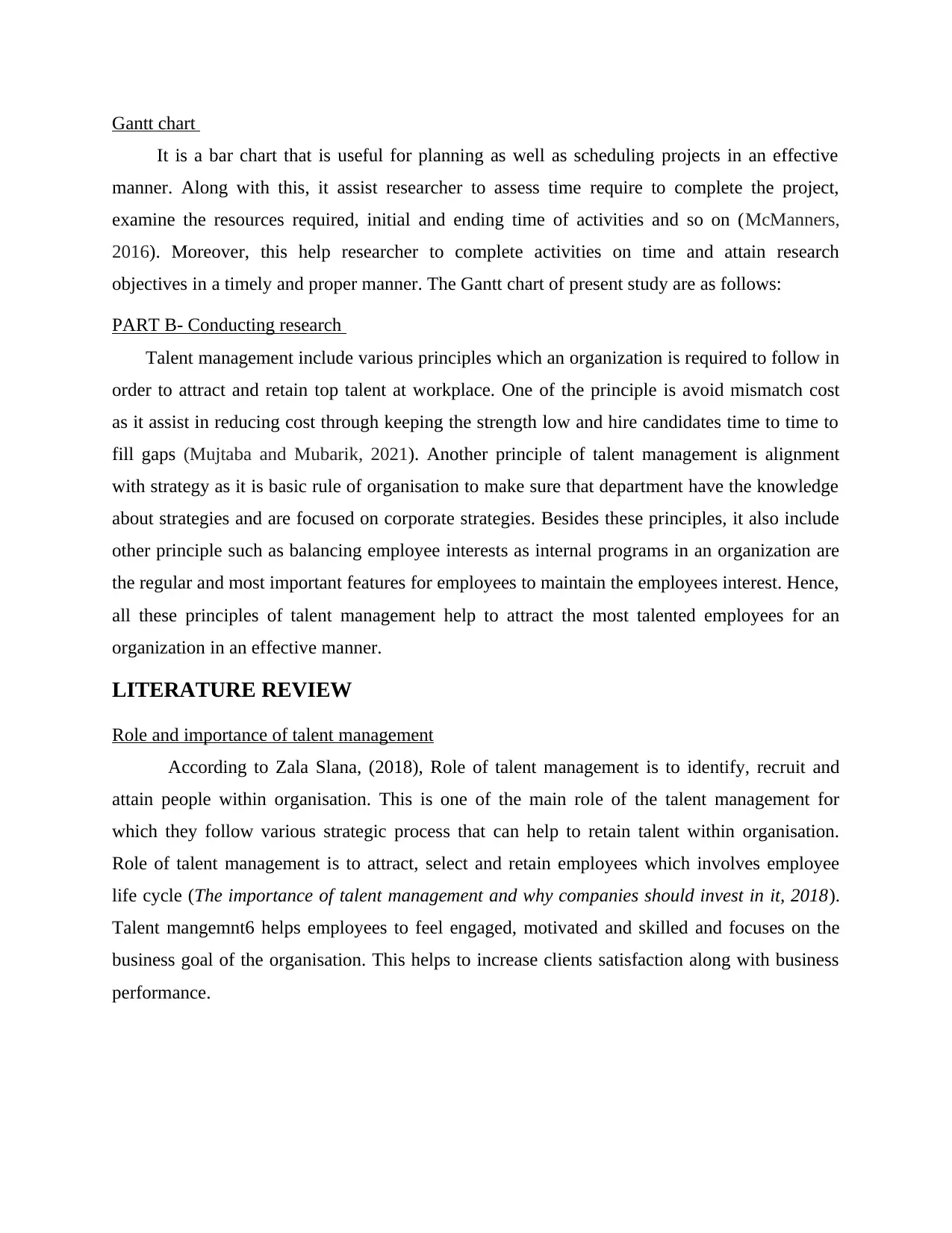
Gantt chart
It is a bar chart that is useful for planning as well as scheduling projects in an effective
manner. Along with this, it assist researcher to assess time require to complete the project,
examine the resources required, initial and ending time of activities and so on (McManners,
2016). Moreover, this help researcher to complete activities on time and attain research
objectives in a timely and proper manner. The Gantt chart of present study are as follows:
PART B- Conducting research
Talent management include various principles which an organization is required to follow in
order to attract and retain top talent at workplace. One of the principle is avoid mismatch cost
as it assist in reducing cost through keeping the strength low and hire candidates time to time to
fill gaps (Mujtaba and Mubarik, 2021). Another principle of talent management is alignment
with strategy as it is basic rule of organisation to make sure that department have the knowledge
about strategies and are focused on corporate strategies. Besides these principles, it also include
other principle such as balancing employee interests as internal programs in an organization are
the regular and most important features for employees to maintain the employees interest. Hence,
all these principles of talent management help to attract the most talented employees for an
organization in an effective manner.
LITERATURE REVIEW
Role and importance of talent management
According to Zala Slana, (2018), Role of talent management is to identify, recruit and
attain people within organisation. This is one of the main role of the talent management for
which they follow various strategic process that can help to retain talent within organisation.
Role of talent management is to attract, select and retain employees which involves employee
life cycle (The importance of talent management and why companies should invest in it, 2018).
Talent mangemnt6 helps employees to feel engaged, motivated and skilled and focuses on the
business goal of the organisation. This helps to increase clients satisfaction along with business
performance.
It is a bar chart that is useful for planning as well as scheduling projects in an effective
manner. Along with this, it assist researcher to assess time require to complete the project,
examine the resources required, initial and ending time of activities and so on (McManners,
2016). Moreover, this help researcher to complete activities on time and attain research
objectives in a timely and proper manner. The Gantt chart of present study are as follows:
PART B- Conducting research
Talent management include various principles which an organization is required to follow in
order to attract and retain top talent at workplace. One of the principle is avoid mismatch cost
as it assist in reducing cost through keeping the strength low and hire candidates time to time to
fill gaps (Mujtaba and Mubarik, 2021). Another principle of talent management is alignment
with strategy as it is basic rule of organisation to make sure that department have the knowledge
about strategies and are focused on corporate strategies. Besides these principles, it also include
other principle such as balancing employee interests as internal programs in an organization are
the regular and most important features for employees to maintain the employees interest. Hence,
all these principles of talent management help to attract the most talented employees for an
organization in an effective manner.
LITERATURE REVIEW
Role and importance of talent management
According to Zala Slana, (2018), Role of talent management is to identify, recruit and
attain people within organisation. This is one of the main role of the talent management for
which they follow various strategic process that can help to retain talent within organisation.
Role of talent management is to attract, select and retain employees which involves employee
life cycle (The importance of talent management and why companies should invest in it, 2018).
Talent mangemnt6 helps employees to feel engaged, motivated and skilled and focuses on the
business goal of the organisation. This helps to increase clients satisfaction along with business
performance.
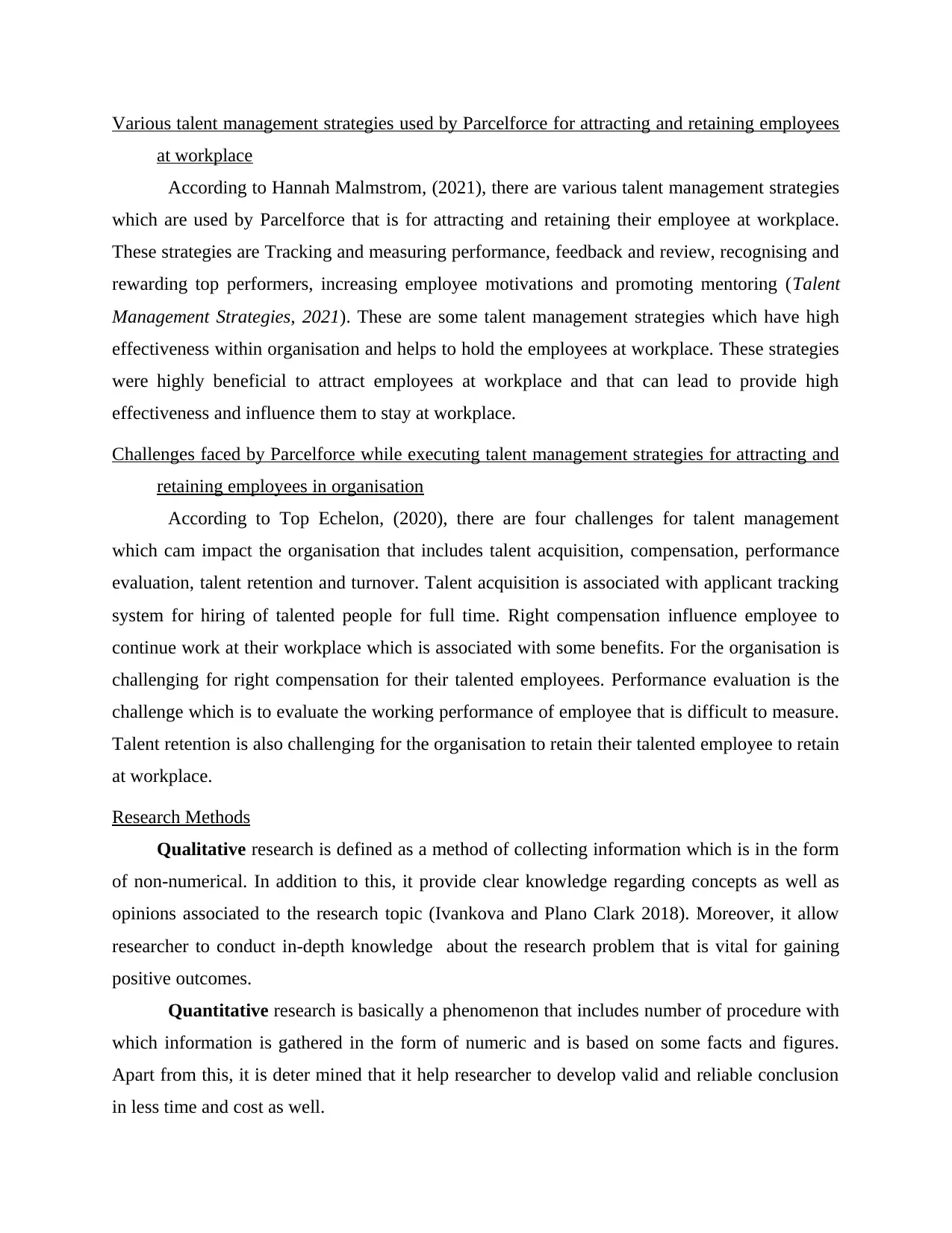
Various talent management strategies used by Parcelforce for attracting and retaining employees
at workplace
According to Hannah Malmstrom, (2021), there are various talent management strategies
which are used by Parcelforce that is for attracting and retaining their employee at workplace.
These strategies are Tracking and measuring performance, feedback and review, recognising and
rewarding top performers, increasing employee motivations and promoting mentoring (Talent
Management Strategies, 2021). These are some talent management strategies which have high
effectiveness within organisation and helps to hold the employees at workplace. These strategies
were highly beneficial to attract employees at workplace and that can lead to provide high
effectiveness and influence them to stay at workplace.
Challenges faced by Parcelforce while executing talent management strategies for attracting and
retaining employees in organisation
According to Top Echelon, (2020), there are four challenges for talent management
which cam impact the organisation that includes talent acquisition, compensation, performance
evaluation, talent retention and turnover. Talent acquisition is associated with applicant tracking
system for hiring of talented people for full time. Right compensation influence employee to
continue work at their workplace which is associated with some benefits. For the organisation is
challenging for right compensation for their talented employees. Performance evaluation is the
challenge which is to evaluate the working performance of employee that is difficult to measure.
Talent retention is also challenging for the organisation to retain their talented employee to retain
at workplace.
Research Methods
Qualitative research is defined as a method of collecting information which is in the form
of non-numerical. In addition to this, it provide clear knowledge regarding concepts as well as
opinions associated to the research topic (Ivankova and Plano Clark 2018). Moreover, it allow
researcher to conduct in-depth knowledge about the research problem that is vital for gaining
positive outcomes.
Quantitative research is basically a phenomenon that includes number of procedure with
which information is gathered in the form of numeric and is based on some facts and figures.
Apart from this, it is deter mined that it help researcher to develop valid and reliable conclusion
in less time and cost as well.
at workplace
According to Hannah Malmstrom, (2021), there are various talent management strategies
which are used by Parcelforce that is for attracting and retaining their employee at workplace.
These strategies are Tracking and measuring performance, feedback and review, recognising and
rewarding top performers, increasing employee motivations and promoting mentoring (Talent
Management Strategies, 2021). These are some talent management strategies which have high
effectiveness within organisation and helps to hold the employees at workplace. These strategies
were highly beneficial to attract employees at workplace and that can lead to provide high
effectiveness and influence them to stay at workplace.
Challenges faced by Parcelforce while executing talent management strategies for attracting and
retaining employees in organisation
According to Top Echelon, (2020), there are four challenges for talent management
which cam impact the organisation that includes talent acquisition, compensation, performance
evaluation, talent retention and turnover. Talent acquisition is associated with applicant tracking
system for hiring of talented people for full time. Right compensation influence employee to
continue work at their workplace which is associated with some benefits. For the organisation is
challenging for right compensation for their talented employees. Performance evaluation is the
challenge which is to evaluate the working performance of employee that is difficult to measure.
Talent retention is also challenging for the organisation to retain their talented employee to retain
at workplace.
Research Methods
Qualitative research is defined as a method of collecting information which is in the form
of non-numerical. In addition to this, it provide clear knowledge regarding concepts as well as
opinions associated to the research topic (Ivankova and Plano Clark 2018). Moreover, it allow
researcher to conduct in-depth knowledge about the research problem that is vital for gaining
positive outcomes.
Quantitative research is basically a phenomenon that includes number of procedure with
which information is gathered in the form of numeric and is based on some facts and figures.
Apart from this, it is deter mined that it help researcher to develop valid and reliable conclusion
in less time and cost as well.
⊘ This is a preview!⊘
Do you want full access?
Subscribe today to unlock all pages.

Trusted by 1+ million students worldwide
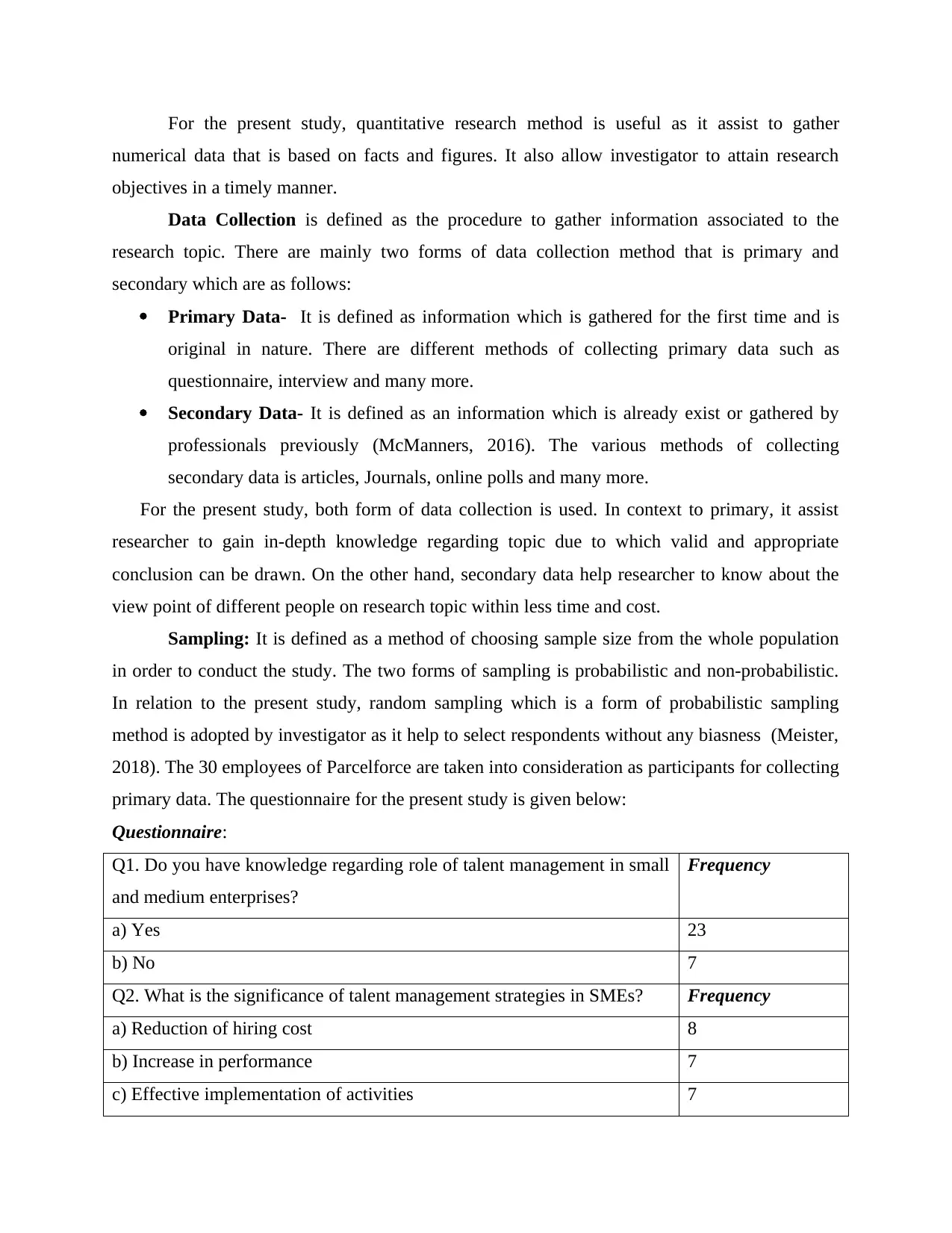
For the present study, quantitative research method is useful as it assist to gather
numerical data that is based on facts and figures. It also allow investigator to attain research
objectives in a timely manner.
Data Collection is defined as the procedure to gather information associated to the
research topic. There are mainly two forms of data collection method that is primary and
secondary which are as follows:
Primary Data- It is defined as information which is gathered for the first time and is
original in nature. There are different methods of collecting primary data such as
questionnaire, interview and many more.
Secondary Data- It is defined as an information which is already exist or gathered by
professionals previously (McManners, 2016). The various methods of collecting
secondary data is articles, Journals, online polls and many more.
For the present study, both form of data collection is used. In context to primary, it assist
researcher to gain in-depth knowledge regarding topic due to which valid and appropriate
conclusion can be drawn. On the other hand, secondary data help researcher to know about the
view point of different people on research topic within less time and cost.
Sampling: It is defined as a method of choosing sample size from the whole population
in order to conduct the study. The two forms of sampling is probabilistic and non-probabilistic.
In relation to the present study, random sampling which is a form of probabilistic sampling
method is adopted by investigator as it help to select respondents without any biasness (Meister,
2018). The 30 employees of Parcelforce are taken into consideration as participants for collecting
primary data. The questionnaire for the present study is given below:
Questionnaire:
Q1. Do you have knowledge regarding role of talent management in small
and medium enterprises?
Frequency
a) Yes 23
b) No 7
Q2. What is the significance of talent management strategies in SMEs? Frequency
a) Reduction of hiring cost 8
b) Increase in performance 7
c) Effective implementation of activities 7
numerical data that is based on facts and figures. It also allow investigator to attain research
objectives in a timely manner.
Data Collection is defined as the procedure to gather information associated to the
research topic. There are mainly two forms of data collection method that is primary and
secondary which are as follows:
Primary Data- It is defined as information which is gathered for the first time and is
original in nature. There are different methods of collecting primary data such as
questionnaire, interview and many more.
Secondary Data- It is defined as an information which is already exist or gathered by
professionals previously (McManners, 2016). The various methods of collecting
secondary data is articles, Journals, online polls and many more.
For the present study, both form of data collection is used. In context to primary, it assist
researcher to gain in-depth knowledge regarding topic due to which valid and appropriate
conclusion can be drawn. On the other hand, secondary data help researcher to know about the
view point of different people on research topic within less time and cost.
Sampling: It is defined as a method of choosing sample size from the whole population
in order to conduct the study. The two forms of sampling is probabilistic and non-probabilistic.
In relation to the present study, random sampling which is a form of probabilistic sampling
method is adopted by investigator as it help to select respondents without any biasness (Meister,
2018). The 30 employees of Parcelforce are taken into consideration as participants for collecting
primary data. The questionnaire for the present study is given below:
Questionnaire:
Q1. Do you have knowledge regarding role of talent management in small
and medium enterprises?
Frequency
a) Yes 23
b) No 7
Q2. What is the significance of talent management strategies in SMEs? Frequency
a) Reduction of hiring cost 8
b) Increase in performance 7
c) Effective implementation of activities 7
Paraphrase This Document
Need a fresh take? Get an instant paraphrase of this document with our AI Paraphraser
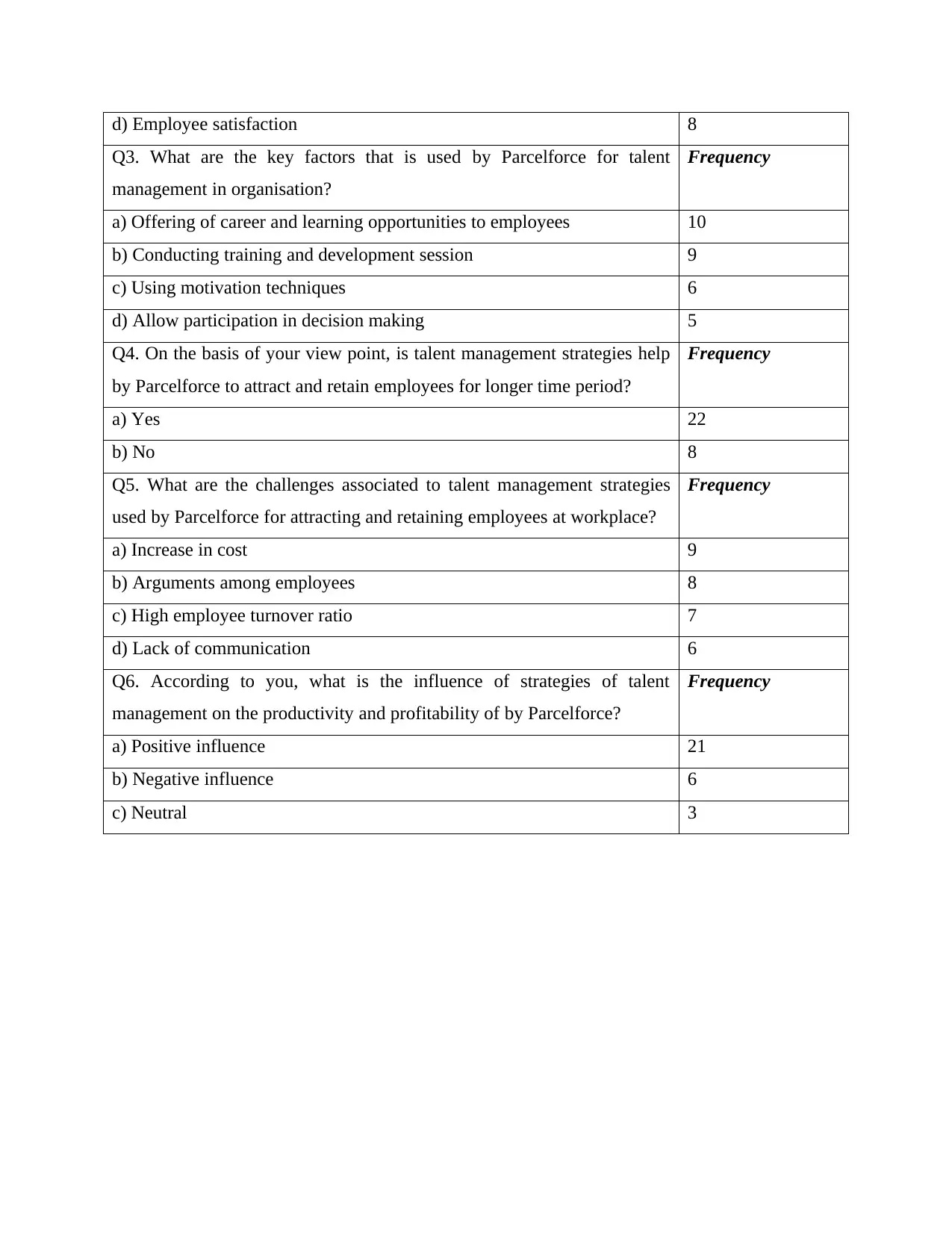
d) Employee satisfaction 8
Q3. What are the key factors that is used by Parcelforce for talent
management in organisation?
Frequency
a) Offering of career and learning opportunities to employees 10
b) Conducting training and development session 9
c) Using motivation techniques 6
d) Allow participation in decision making 5
Q4. On the basis of your view point, is talent management strategies help
by Parcelforce to attract and retain employees for longer time period?
Frequency
a) Yes 22
b) No 8
Q5. What are the challenges associated to talent management strategies
used by Parcelforce for attracting and retaining employees at workplace?
Frequency
a) Increase in cost 9
b) Arguments among employees 8
c) High employee turnover ratio 7
d) Lack of communication 6
Q6. According to you, what is the influence of strategies of talent
management on the productivity and profitability of by Parcelforce?
Frequency
a) Positive influence 21
b) Negative influence 6
c) Neutral 3
Q3. What are the key factors that is used by Parcelforce for talent
management in organisation?
Frequency
a) Offering of career and learning opportunities to employees 10
b) Conducting training and development session 9
c) Using motivation techniques 6
d) Allow participation in decision making 5
Q4. On the basis of your view point, is talent management strategies help
by Parcelforce to attract and retain employees for longer time period?
Frequency
a) Yes 22
b) No 8
Q5. What are the challenges associated to talent management strategies
used by Parcelforce for attracting and retaining employees at workplace?
Frequency
a) Increase in cost 9
b) Arguments among employees 8
c) High employee turnover ratio 7
d) Lack of communication 6
Q6. According to you, what is the influence of strategies of talent
management on the productivity and profitability of by Parcelforce?
Frequency
a) Positive influence 21
b) Negative influence 6
c) Neutral 3
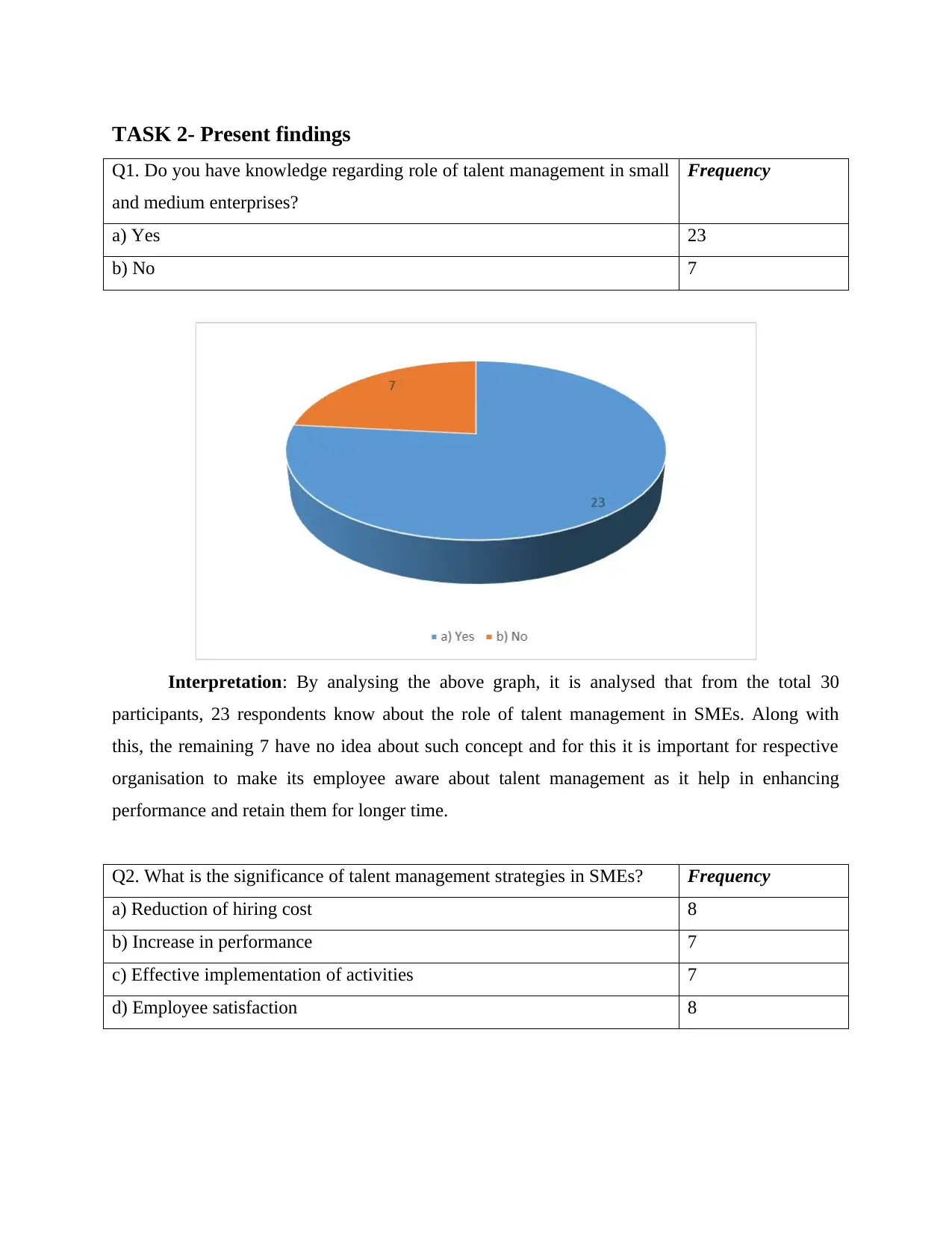
TASK 2- Present findings
Q1. Do you have knowledge regarding role of talent management in small
and medium enterprises?
Frequency
a) Yes 23
b) No 7
Interpretation: By analysing the above graph, it is analysed that from the total 30
participants, 23 respondents know about the role of talent management in SMEs. Along with
this, the remaining 7 have no idea about such concept and for this it is important for respective
organisation to make its employee aware about talent management as it help in enhancing
performance and retain them for longer time.
Q2. What is the significance of talent management strategies in SMEs? Frequency
a) Reduction of hiring cost 8
b) Increase in performance 7
c) Effective implementation of activities 7
d) Employee satisfaction 8
Q1. Do you have knowledge regarding role of talent management in small
and medium enterprises?
Frequency
a) Yes 23
b) No 7
Interpretation: By analysing the above graph, it is analysed that from the total 30
participants, 23 respondents know about the role of talent management in SMEs. Along with
this, the remaining 7 have no idea about such concept and for this it is important for respective
organisation to make its employee aware about talent management as it help in enhancing
performance and retain them for longer time.
Q2. What is the significance of talent management strategies in SMEs? Frequency
a) Reduction of hiring cost 8
b) Increase in performance 7
c) Effective implementation of activities 7
d) Employee satisfaction 8
⊘ This is a preview!⊘
Do you want full access?
Subscribe today to unlock all pages.

Trusted by 1+ million students worldwide
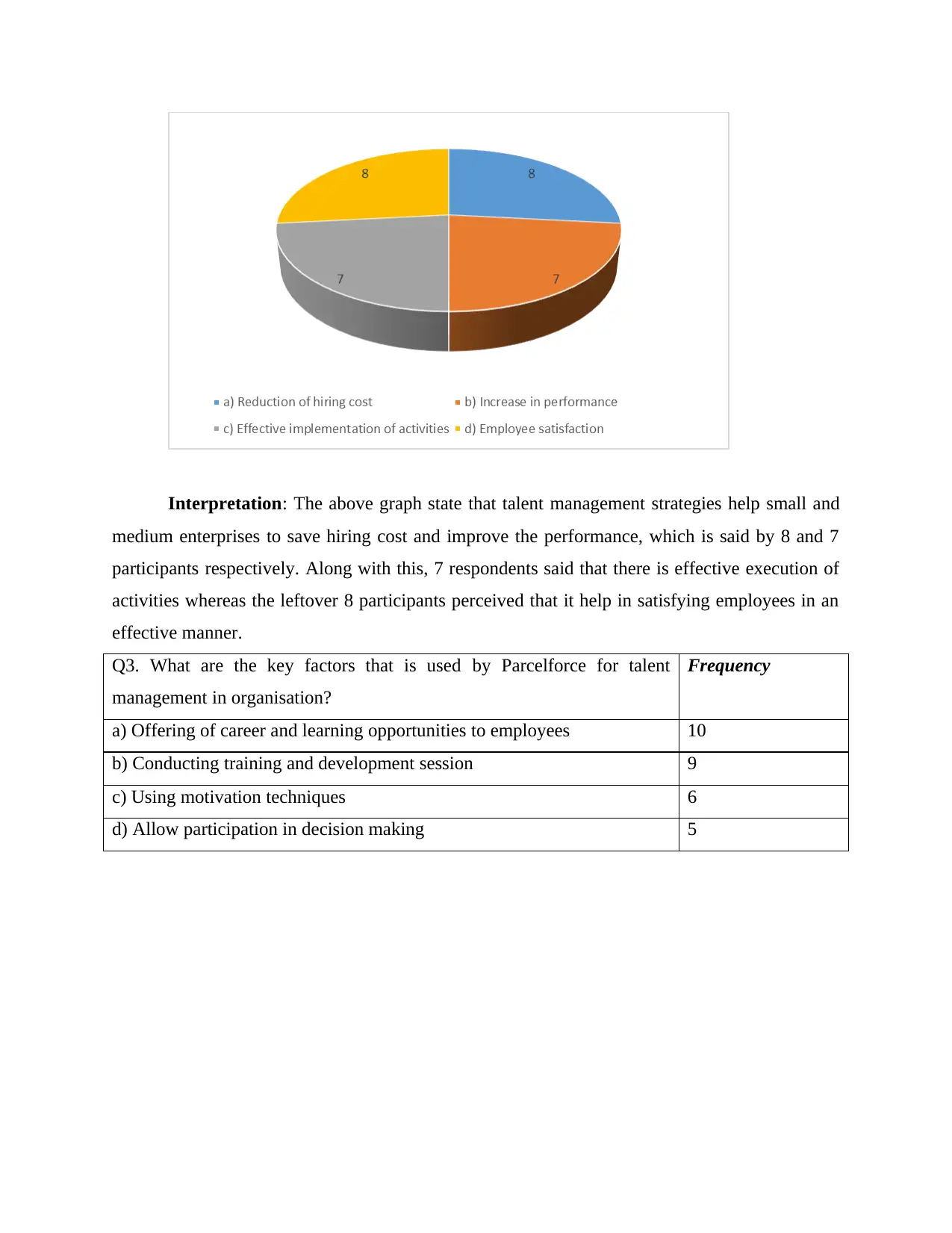
Interpretation: The above graph state that talent management strategies help small and
medium enterprises to save hiring cost and improve the performance, which is said by 8 and 7
participants respectively. Along with this, 7 respondents said that there is effective execution of
activities whereas the leftover 8 participants perceived that it help in satisfying employees in an
effective manner.
Q3. What are the key factors that is used by Parcelforce for talent
management in organisation?
Frequency
a) Offering of career and learning opportunities to employees 10
b) Conducting training and development session 9
c) Using motivation techniques 6
d) Allow participation in decision making 5
medium enterprises to save hiring cost and improve the performance, which is said by 8 and 7
participants respectively. Along with this, 7 respondents said that there is effective execution of
activities whereas the leftover 8 participants perceived that it help in satisfying employees in an
effective manner.
Q3. What are the key factors that is used by Parcelforce for talent
management in organisation?
Frequency
a) Offering of career and learning opportunities to employees 10
b) Conducting training and development session 9
c) Using motivation techniques 6
d) Allow participation in decision making 5
Paraphrase This Document
Need a fresh take? Get an instant paraphrase of this document with our AI Paraphraser
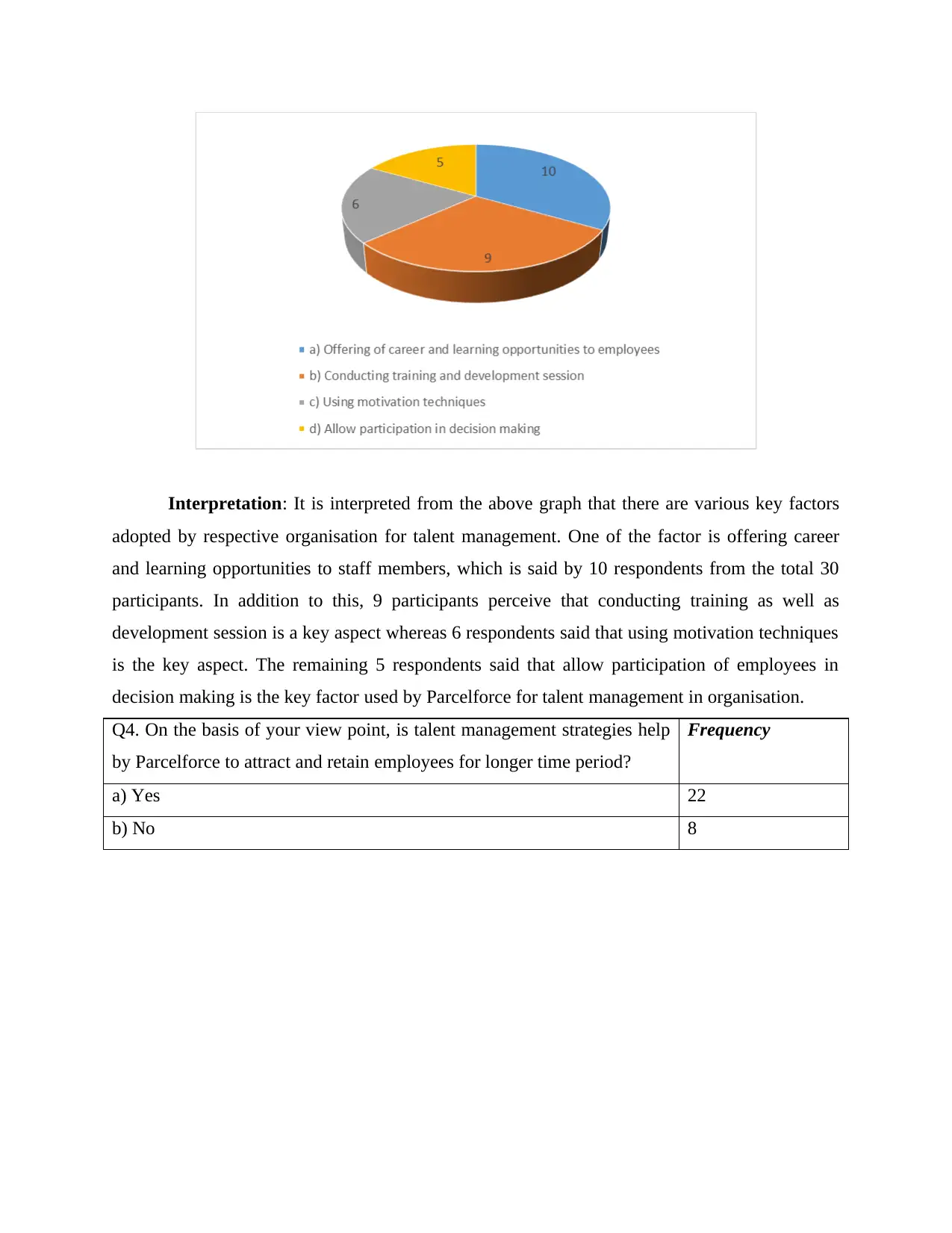
Interpretation: It is interpreted from the above graph that there are various key factors
adopted by respective organisation for talent management. One of the factor is offering career
and learning opportunities to staff members, which is said by 10 respondents from the total 30
participants. In addition to this, 9 participants perceive that conducting training as well as
development session is a key aspect whereas 6 respondents said that using motivation techniques
is the key aspect. The remaining 5 respondents said that allow participation of employees in
decision making is the key factor used by Parcelforce for talent management in organisation.
Q4. On the basis of your view point, is talent management strategies help
by Parcelforce to attract and retain employees for longer time period?
Frequency
a) Yes 22
b) No 8
adopted by respective organisation for talent management. One of the factor is offering career
and learning opportunities to staff members, which is said by 10 respondents from the total 30
participants. In addition to this, 9 participants perceive that conducting training as well as
development session is a key aspect whereas 6 respondents said that using motivation techniques
is the key aspect. The remaining 5 respondents said that allow participation of employees in
decision making is the key factor used by Parcelforce for talent management in organisation.
Q4. On the basis of your view point, is talent management strategies help
by Parcelforce to attract and retain employees for longer time period?
Frequency
a) Yes 22
b) No 8
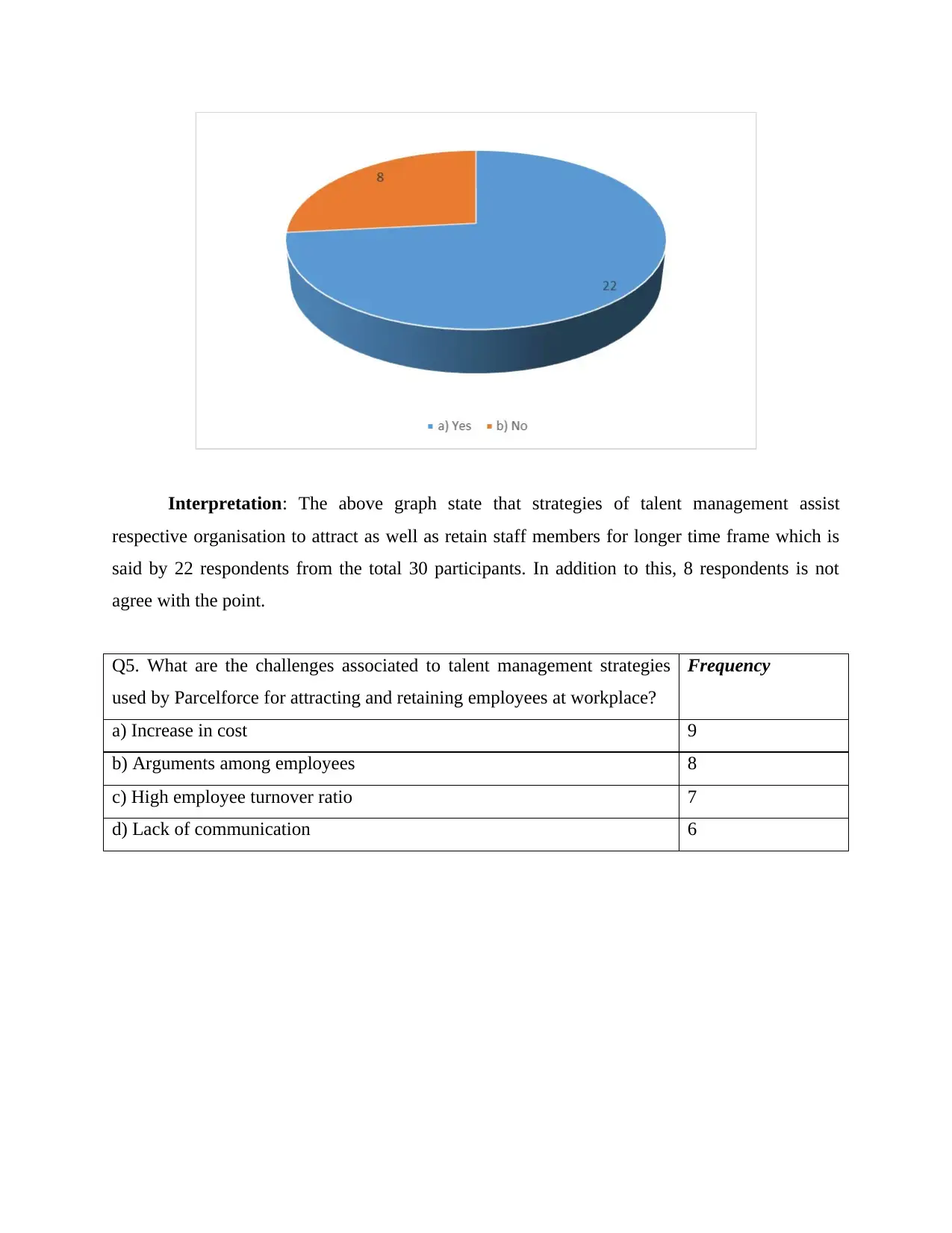
Interpretation: The above graph state that strategies of talent management assist
respective organisation to attract as well as retain staff members for longer time frame which is
said by 22 respondents from the total 30 participants. In addition to this, 8 respondents is not
agree with the point.
Q5. What are the challenges associated to talent management strategies
used by Parcelforce for attracting and retaining employees at workplace?
Frequency
a) Increase in cost 9
b) Arguments among employees 8
c) High employee turnover ratio 7
d) Lack of communication 6
respective organisation to attract as well as retain staff members for longer time frame which is
said by 22 respondents from the total 30 participants. In addition to this, 8 respondents is not
agree with the point.
Q5. What are the challenges associated to talent management strategies
used by Parcelforce for attracting and retaining employees at workplace?
Frequency
a) Increase in cost 9
b) Arguments among employees 8
c) High employee turnover ratio 7
d) Lack of communication 6
⊘ This is a preview!⊘
Do you want full access?
Subscribe today to unlock all pages.

Trusted by 1+ million students worldwide
1 out of 23
Related Documents
Your All-in-One AI-Powered Toolkit for Academic Success.
+13062052269
info@desklib.com
Available 24*7 on WhatsApp / Email
![[object Object]](/_next/static/media/star-bottom.7253800d.svg)
Unlock your academic potential
Copyright © 2020–2025 A2Z Services. All Rights Reserved. Developed and managed by ZUCOL.




